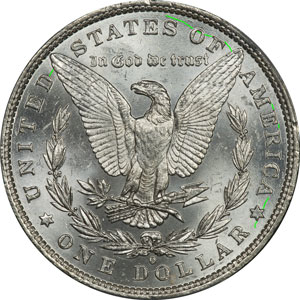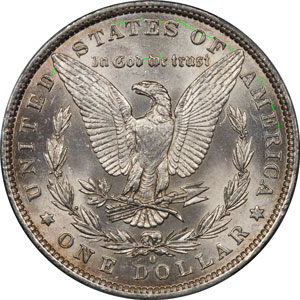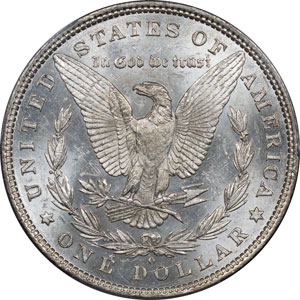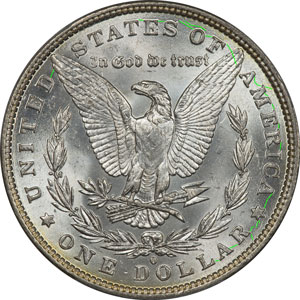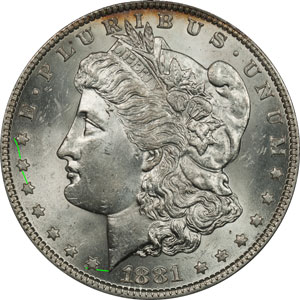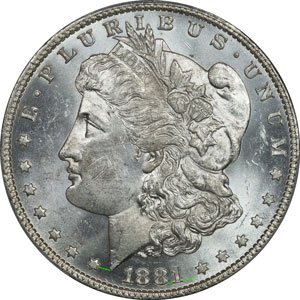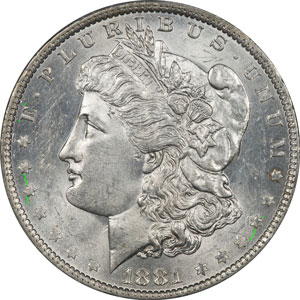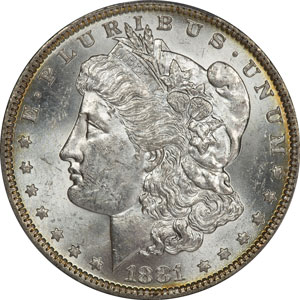
February 2018 - Welcome
Sources
Search
Contact
Home
Welcome
Click on year to expand
2022
2021
2020
2019
2018
2017
2016
2015
Welcome
Key VAMs in the Series
Die Fingerprints
2018 is shaping up to be a great year with more measured purchases and lots of in-depth analysis of our existing inventory.
![]()
![]() VSS Submission
VSS Submission
Right now we are awaiting the return of a bulk submission from PCGS to see how far we moved toward our 2018 goal of 1,000 coins. We already have 949 PCGS graded coins even though only 924 are visible on the web site. The return of the 20 coins in our bulk submission will tell us how far we moved toward that goal.
![]()
![]() LVA January Supplement
LVA January Supplement
We are assuming that the LVA January Supplement will be delayed a month or so, but this one will be important for us. JB asked for clarification on several VAMs that we believe are duplicates. The most important of these may be the overlap between VAMs 21 and 25.
![]()
![]() Web Site Change
Web Site Change
Last month we made a needed change to the page that showed all coins and moved all those coins to a grade-by-grade page. This will make the maintenance of the web site much easier without much loss in ability to view the collection.
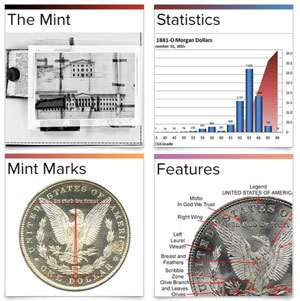 This month we changed the navigation within sections of the web site to make them more consistent. The existing visual links were all built at different times and we lost any consistency along the road. All of these have been posted and that frees us to work within Photoshop much easier to build new links.
This month we changed the navigation within sections of the web site to make them more consistent. The existing visual links were all built at different times and we lost any consistency along the road. All of these have been posted and that frees us to work within Photoshop much easier to build new links.
![]()
![]() A Technical Pause
A Technical Pause
From time to time we have to take a major hardware upgrade step and hope that the change will last long enough to make it worth the effort. We are at the point of upgrade and have spent a portion of our time in January assessing our needs, placing orders, backing up data, and doing all the other little things you have to do to upgrade a system.

Our new system arrived on January 30 and it is large enough to last for quite a while. Non-teckies would get bored, but it is a high end gaming system with a lot of capacity. But for us the most important improvement is two thirty-five inch monitors which will help our aging eyes. A portion of our February time is going to be spent making this transition.
For better or worse, PCGS designates only three VAMs for certification for the 1881-O. The VAMs are 1D, 5, and 27. Although expensive, we have decided to route our finds for these three through PCGS for certification to make the census more accurate.
It would be prohibitively expensive to back up and re-certify all our inventory for these three, but we can go down this road with new coins. We will maintain our image consistency by having VSS continue with the photography once the coins are certified.
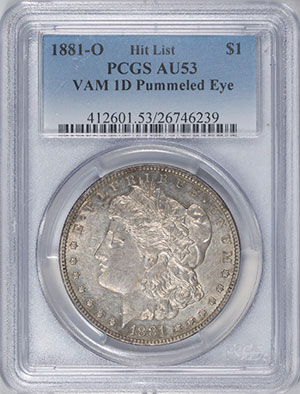
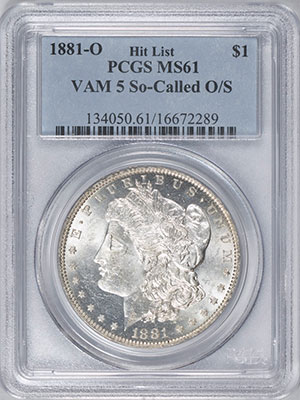
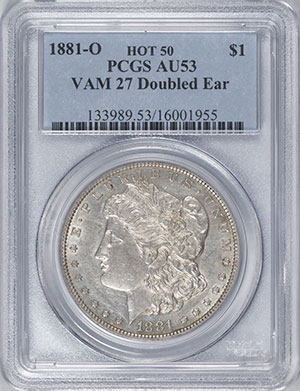
We continue to work on the reverse die fingerprints and we are making some progress. Last month we only tackled Die b, but there is much more to do. The reverse dies seem to have been given less study in the past with the bulk of them grouped into Die a.
So where to head next has been the issue. We have been picking off the dies starting with the less complex ones. But those are behind us and now we have to dig in to other, more complex VAM groupings.
There is also a potential issue of the LVA January supplement and our request for review of several VAMs as possible duplicates. If those prove to be duplicates then some of the obverse and reverse dies could be consolidated in the process of consolidating VAMs.
While a number of possibilities were considered, we decided to tackle Die a. This could take months, but it also could provide a lot of new data for grouping die usage. There are currently 54 VAMs with Die a as the designated reverse die. But the die cracks may just begin to bring some clarity to the Die a designations.
To help differentiate the die identification we will list the associated VAM and Obverse Die pairing.
VAM 1A - Spike in 8
This examination has already produce some discussion and fruit and it starts with VAM 1A - Spike in 8. See our note below on the findings.
VAMs with "Die Gouge in DOL"
So that transitions us to the next grouping, the VAMs with the designation of "Die Gouge DOL". There are five of these as of January 2018 and they are VAMs 1B1, 1B2, 18, 43, and 49.
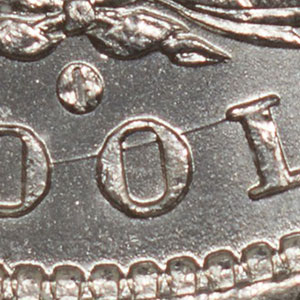 All five have a Reverse Die a designation and have the common characteristic of the upward sloping die gouge through DOL in DOLLAR. The positioning of the gouge is always consistent, leading one to conclude that this is but one die and the VAM differentiation is the obverse pairing.
All five have a Reverse Die a designation and have the common characteristic of the upward sloping die gouge through DOL in DOLLAR. The positioning of the gouge is always consistent, leading one to conclude that this is but one die and the VAM differentiation is the obverse pairing.
But there is much to be learned with this grouping such as verification of which VAM came first? When were other characteristics introduced to the die? Are there other features that might separate this grouping from the other Reverse Die a VAMs? But for this study, what do the die cracks tell us is our focus?
Morgan Dollar "Fingerprints"
Morgan Dollar "Fingerprints"
Reverse Die a (VAM 1B2)
Reverse Die a (VAM 43)
In May 2017 we started an analysis of die cracks that we are likening to the uniqueness of fingerprints. We continue that analysis this month with the first of the reverse die analyses.
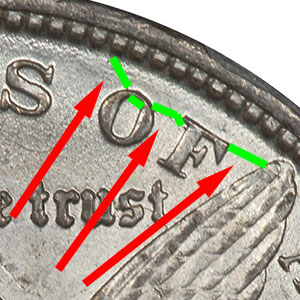
To observe the die cracks and breaks magnification is often needed. Also, high quality images such as the ones we use from VSS also help. Some die cracks are more visible in the high quality images because contrast is easier to create, which reveals the cracks. This analysis is really getting "down in the weeds," but that is a part of what makes this fun. Please remember that you are looking at later die states in most cases and coins of the same die/VAM combination will exist without many of these features.
Reverse Die a (VAM 1A)
You have to start somewhere, and this is the logical jumping off point. But the review of the coins in our inventory classified as VAM 1A - Spike in 8 led us to question its existence other than as a theoretical VAM.
When discovered in 1974 the hobby was different and it is highly likely that VAM 1A has been displaced by subsequent VAMs as we look at the dies with greater granularity.
It is possible that a coin with no distinguishing characteristics other than the "Spike in 8" exists, we just have not seen one. The coins we have had categorized as this VAM will be moved because we have found distinguishing characteristics worth noting.
Reverse Die a (VAM 1B1)
We have eight coins in our inventory designated as VAM 1B1 - Die Gouge in DOL & Denticle Impressions above DOL. This one can be a little confusing because the die can exist with or without the denticle impressions since they wore away quickly. It can also exist with or without a clashed obverse s when paired with Obverse Die 1.
34089026 Mint State 63
This is our most extreme example, but all eight of our coins show the same consistent die cracks shown on this image and stay near the rim. None of them show any signs of significant repolishing.
We have twelve examples of VAM 1B2 - Die Gouge in DOLLAR, Clashed Obverse n & st. Like VAM 1B1 this is a marriage of Obverse Die 1 and Reverse Die a, but is double clashed at the neck as a distinguishing characteristic. It appears that the die cracks and polishing of the die are in alignment with VAM 1B1 and that if the die was repolished then it happened after VAM 1B2.
33582014 Mint State 63
As with VAM 1B1, many of the die cracks are just beginning to appear. Of particular interest is that the obverse and reverse die cracks align which would indicate that there was no change in the physical dies during the formation of these two VAMs.
Reverse Die a (VAM 18)
VAM 18 - Doubled 18, Die Gouge DOL seems to be available but not common. We have five examples that range in grade from Almost Uncirculated 50 to Mint State 62. Some of our best images are from an AU58 coin and we will use it in our illustrations.
26039795 Almost Uncirculated 58
None of our five examples show any signs of die cracks or breaks, indicating that this VAM probably preceded VAMs 1B1 and 1B2 in use.
This can also be confirmed because the obverse die used for VAMs 1B1 and 1B2 are further along the polishing sequence than VAM 18.
VAM 43 - Doubled Left 8 & Phrygian Cap, Die Gouge DOL seems to be available but somewhat rare and it took us several years to acquire a mere two examples. One of these is an Almost Uncirculated 53 and the other a Mint State 63.
VAM 43 is a pairing of Obverse Die 29 and Reverse Die a.
84722242 Mint State 63
The reverse die cracks follow the same pattern as all the others so we are confident of this being the same reverse die.
Reverse Die a (VAM 49)
VAM 49 - Doubled 1-1, Die Gouge DOL is also relatively difficult to find and we have only three examples ranging from Extra Fine 45 to Mint State 62. VAM 49 is defined as the pairing of Obverse Die 13 with Reverse Die a.
32125849 Mint State 62
On VAM 49 the reverse die exhibits the greatest deterioration and shows a die crack progression that matches the others, just to a greater extent.
The Gouge in DOL Group Analysis
We now have the analysis of both the obverse and reverse dies for the five VAMs that feature the Gouge in DOL and there is more to learn by piecing the die analysis together. Issues like how do we validate the die designation beyond the gouge in DOL, which came first, and are the obverse dies the same or different?
Are all the reverse dies the same?
The gouge through DOL is so distinctive that it is almost assured that the VAMs were all struck from the same reverse die. The die cracks for all five VAMs do in fact line up with the exception of VAM 18 which shows no signs of die cracks, but once again the distinctive die gouge is proof. There are other markers to prove the die linkage in the form of pitting in the wing-neck gap, a unique leaf deterioration in the third left cluster, and some other minor similarities.
Which came first?
Often this can be a difficult question because of repolishing to remove minor die cracks, but in this case we believe you can tell because only VAM 49 seems to show signs of repolishing in the right wing. Based on the die cracks and deterioration we believe the sequence for reverse die usage is:
- 18 - Doubled 18, Die Gouge in DOLLAR & Denticle Edge Impression
- 43 - Doubled Left 8 & Phrygian Cap, Die Gouge DOL
- 1B2 - Die Gouge in DOLLAR, Clashed Obverse n & st
- 1B1 - Die Gouge in DOL & Denticle Impressions above DOL
- 49 - Doubled 1- -1, Die Gouge DOL
The above links take you to the matrix page showing the obverse and reverse pairings so you can see both.
Are the obverse dies the same?
This is where things get a little more interesting because on VAMworld we have four different obverse die designations and links to other VAMs outside this set.
VAM and Description
18 - Doubled 18, Die Gouge in DOLLAR & Denticle Edge Impression
43 - Doubled Left 8 & Phrygian Cap, Die Gouge DOL
1B2 - Die Gouge in DOLLAR, Clashed Obverse n & st
1B1 - Die Gouge in DOL & Denticle Impressions above DOL
49 - Doubled 1- -1, Die Gouge DOL
Obverse Die
10
29
10
1
13
Reverse Die
a
a
a
a
a
To be continued!
When we started this discussion we thought it might be pretty much a straightforward confirmation of the die information on these five VAMs. But the similarity of the reverse dies is obvious and confirmation of those is straightforward.
The obverse dies are a different story and need more work. So in February we plan to spend more time with the coins in these five VAMs to see if there are similarities we can confirm that would clarify the obverse die designations.
As of right now we are leaning toward the obverse die for VAMs 18, 1B1, 1B2, and 43 all being the same. On initial investigation the obverse die for VAM 49 appears to be different. There are a lot of coins to go through to confirm these preliminary assumptions, and we need to look for other obverse similarities to confirm or reject the die links.
Nobody said this was easy!
Getting Started
Collecting The 1881-O
The 1881-O VAMs





















